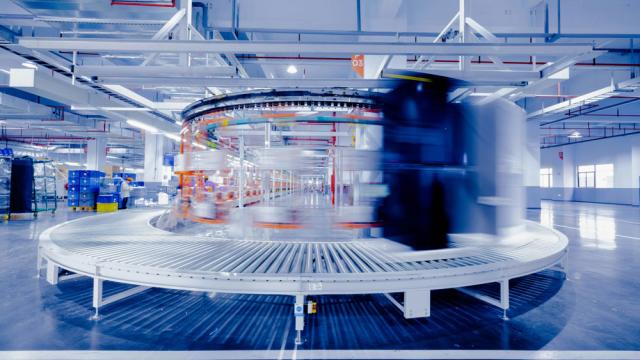All Features

Mike Figliuolo
Staff meetings can be incredibly productive. Or unproductive—and more often the latter. If your staff meetings are terrible, it’s your fault because you’re not structuring them well.
One of the most surreal business experiences I’ve ever had relates to a staff meeting. I’d joined a new team, and…

Bryan Christiansen
From manufacturing and mining to hospitality and healthcare, computerized maintenance management systems (CMMS) have become all but essential. Wherever there are assets to maintain, a CMMS plays a critical role in reducing downtime, controlling costs, and keeping operations running smoothly.
But…

Harish Jose
In this article, I want to explore an idea that often is framed in moral terms but is actually a cybernetic imperative: the necessity of diversity for viable systems. Whether we’re talking about societies, organizations, or even artificial intelligence systems, the principle remains consistent. A…

ISO
In 2021, container ships idled for weeks outside the Port of Los Angeles, a stark visual reminder of just how fragile modern supply-chain reliability had become. The backlog sent shockwaves across industries. Factories stalled, shelves emptied, and businesses scrambled for alternatives. It was a…

Elizabeth Weddle
The quality systems most medtech teams are stuck with aren’t built for how they work today. 21 CFR Part 820 was authorized by the Federal Food, Drug, and Cosmetic Act of 1978, long before the software industry even existed. And while the regulations themselves aren’t going anywhere, the world they…

Adam Zewe
What can we learn about human intelligence by studying how machines “think?” Can we better understand ourselves if we better understand the artificial intelligence systems that are becoming a more significant part of our everyday lives?
These questions may be deeply philosophical, but for Phillip…

Stephanie Ojeda
Implementing a new quality management system (QMS) is no small task, especially for life science companies faced with stringent regulatory requirements and a high validation burden. Entrenched legacy systems compound the problem as organizational inertia and complacency lead companies to make do…

David Schwinn
I’ve been in and around the quality profession for decades. When I first started, we were most concerned about products failing in our customers’ hands... too often and too soon. I worked at General Motors in those days, in the Frigidaire division when Frigidaire was part of General Motors. We made…

James Glover
Your facility has detailed standard operating procedures (SOPs), ISO certifications, and quality management systems that would impress any auditor. But operators still skip calibration checks when production is behind, modify machine settings without authorization during shift changes, and forget…

Nimax
The global coding- and marking-equipment market is on a clear growth path. As shown in a recent Grand View Research report, the market was worth $17,528 million worldwide by the end of 2024.
Furthermore, GVR’s projections estimate the market value will reach $24,927 million by 2030, with a…

Adam Grabowski
To stay profitable as a manufacturer, you have to run a tight ship. I’ve been lucky enough to visit with owners and key people at thousands of manufacturers all over the world. My main goal during these visits is to listen and learn what makes them so good at what they do.
It turns out that the…

Curtis Lynn
I’ve worked in manufacturing procurement for just over 25 years. In that time, I’ve learned one thing above all else—precision is the backbone of quality. Every product we make, every part we produce, and every component we measure relies on measuring tool accuracy. If measurements are off, quality…

Akhilesh Gulati
Meritocracy—the idea that individuals should advance based on their talent and hard work—appeals to our sense of fairness. However, despite its noble intentions, meritocracy often fails in practice.
Emilio J. Castilla’s The Meritocracy Paradox (Columbia University Press, 2025) highlights how…

Kate Zabriskie
When most people think about work, fun probably isn’t the first word that comes to mind. Deadlines, meetings, and spreadsheets? Sure. But laughter, camaraderie, and a little silliness? That often feels like a luxury, not a priority.
Here’s the truth: Fun at work isn’t just about blowing off steam…

Mike King
Change is inevitable in manufacturing. Controlling change effectively distinguishes industry leaders from quality-deficient, recall-plagued, and regulatory-troubled companies. As organizations are increasingly pressured to reduce costs while maintaining high levels of product quality, the drive to…

Stephanie Ojeda
When organizations implement an enterprise quality management system (EQMS), the instinct is often to begin with high-visibility processes like corrective and preventive action (CAPA) or supplier quality. While these functions are critical, starting there can be a misstep. Without the right…

Harish Jose
In this article I want to explore an observation on how we make distinctions and what this reveals about the structure of our thinking. I’m inspired by the ideas in George Spencer-Brown’s Laws of Form and broader themes in cybernetics about how observers construct meaning.
The starting point is…

Harikrishna Kundariya
AI has amazing capabilities, and it’s one of the best technologies for the future. It’s helping to change the world and bringing productivity enhancements across industries with its exceptional use cases. Quality assurance isn’t left out, either. AI is highly useful in any product development…

Robin F. Goldsmith
Many organizations have decided to automate their quality management system (QMS) or upgrade their currently automated QMS. Quality management tends to involve significant numbers of documents, which automated systems are especially efficient at creating, accessing, tracking, updating, and…

Lexi Sharkov
When an issue arises, it’s important to take quick action. Whether that means launching a software patch, pulling a batch, or halting the use of a reagent, it’s critical to tackle the immediate problem.
But just as critical as “How do we fix this?” is “How do we make sure this doesn’t happen again…

Charleen Newland
Many organizations list continuous improvement (CI) as a priority, but it often fails to take root in day-to-day work. It appears as a workshop or a one-off initiative, then fades without lasting change. If the goal is long-term performance and sustainable growth, CI can’t be incidental or optional…

Adam Grabowski
Capturing real-time data in all areas of the business is vital for maintaining long-term success. When manufacturers conduct business with separate systems, data end up in silos, and information can’t flow in an efficient manner. This prevents smooth coordination of data between people and…

Troy Harrison
A recent company meeting revealed what management called a “handoff problem.” The sales team would close deals, then toss them over the wall to the service team, which would promptly fumble the relationship because they didn’t understand what had been promised or why the customer bought in the…

Scott Ginsberg
In manufacturing, the term connected worker has quickly gone from emerging concept to executive mandate. As companies grapple with turnover, skill gaps, and increasing complexity, the urgency to modernize frontline work has never been clearer.
What is a connected worker platform?
A connected…

Mike Figliuolo
Most negotiations have an opening bid. That bid becomes the anchor that the rest of the negotiation centers upon. If you’re good at setting anchors—and avoiding being anchored to a number you won’t like—you’ll get more out of your negotiations.
An interesting dynamic that can happen in…